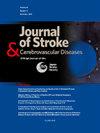Epidemiological trends and forecasts in stroke at global, regional and national levels
IF 2
4区 医学
Q3 NEUROSCIENCES
Journal of Stroke & Cerebrovascular Diseases
Pub Date : 2025-05-15
DOI:10.1016/j.jstrokecerebrovasdis.2025.108347
引用次数: 0
Abstract
Background
Stroke, characterized as ischemic or hemorrhagic, leads to severe morbidity, mortality, and recurrence. This research analyzed stroke epidemiological trends from 1990-2021.
Methods
The Global Burden of Disease database provided stroke data including incidence, mortality, and disability-adjusted life-years (DALYs). Age-standardized rates (ASRs) and Estimated Annual Percent Changes (EAPC) measured incidence and mortality shifts. The sociodemographic index (SDI) was explored alongside stroke burden. Forecasting of stroke trends until 2035 utilized the Bayesian age-period-cohort (BAPC) model. The factors influencing the variability of stroke burden were subjected to decomposition analysis for a more in-depth examination. Additionally, frontier analysis was employed to visually illustrate the opportunities for alleviating burden in each nation or region, taking into account their respective stages of development.This study utilized the slope index of inequality (SII) and the concentration index, as defined by the World Health Organization (WHO), to assess absolute and relative inequalities in disease burden.
Results
From 1990-2021, global stroke incidence increased by 15.03 %, with an overall decline in age-standardized incidence rate (ASIR). Lower in females than males, the incidence rise was larger in females. Stroke mortality declined by 2.60 % overall, with a rise in male mortality and decrease in female mortality. DALYs increased, with a 10.67 % decline by rate per 100,000 people. Eastern Europe, Central Asia, and East Asia experienced the highest incidence rates, with the greatest ASIR decline in the high-income Asia Pacific region. The decomposition analysis revealed a notable rise in Disability-Adjusted Life Years (DALYs) within the middle Socio-Demographic Index (SDI) quintile region, where factors such as aging and population growth were identified as primary contributing elements. Additionally, the frontier analysis indicated that nations or regions categorized within higher SDI quintiles are likely to exhibit greater potential for improvement. Projections for 2035 anticipate increased stroke cases alongside further ASIR and ASMR declines. Cross-country inequality analysis suggests that both absolute and relative health inequalities associated with the stroke burden have escalated during the period from 1990 to 2021.
Conclusion
Despite rising global stroke incidence and DALYs, decreases were seen in ASIR and ASMR since 1990. Incidence rates increased most quickly in females, with regional variation observable. High systolic blood pressure remained a key risk factor. Future efforts should target prevention and treatment to mitigate sex, age, and regional stroke disparities.
全球、区域和国家各级脑卒中的流行病学趋势和预测
背景:中风以缺血性或出血性为特征,可导致严重的发病率、死亡率和复发率。本研究分析了1990-2021年中风流行病学趋势。方法全球疾病负担数据库提供卒中数据,包括发病率、死亡率和残疾调整生命年(DALYs)。年龄标准化率(ASRs)和估计年百分比变化(EAPC)测量了发病率和死亡率的变化。社会人口统计指数(SDI)与脑卒中负担进行了探讨。使用贝叶斯年龄-时期-队列(BAPC)模型预测2035年之前的中风趋势。对影响脑卒中负担变异性的因素进行分解分析,以进行更深入的研究。此外,考虑到每个国家或地区各自的发展阶段,采用前沿分析直观地说明减轻负担的机会。本研究采用世界卫生组织(WHO)定义的不平等斜率指数(SII)和浓度指数来评估疾病负担的绝对不平等和相对不平等。结果1990-2021年,全球脑卒中发病率上升15.03%,年龄标准化发病率(ASIR)总体下降。女性发病率低于男性,女性发病率上升幅度较大。中风死亡率总体下降了2.60%,男性死亡率上升,女性死亡率下降。DALYs增加,每10万人的比率下降10.67%。东欧、中亚和东亚的发病率最高,高收入亚太地区的ASIR下降幅度最大。分解分析显示,在社会人口指数(SDI)的中间五分位数区域,残疾调整生命年(DALYs)显著上升,其中老龄化和人口增长等因素被确定为主要影响因素。此外,前沿分析表明,SDI较高的国家或地区可能表现出更大的改善潜力。对2035年的预测表明,随着ASIR和ASMR的进一步下降,中风病例将会增加。跨国不平等分析表明,在1990年至2021年期间,与中风负担相关的绝对和相对健康不平等都有所升级。结论:尽管全球卒中发病率和DALYs上升,但ASIR和ASMR自1990年以来呈下降趋势。发病率在女性中增长最快,且存在明显的区域差异。高收缩压仍然是一个关键的危险因素。未来的努力应以预防和治疗为目标,以减轻性别、年龄和地区卒中差异。
本文章由计算机程序翻译,如有差异,请以英文原文为准。
求助全文
约1分钟内获得全文
求助全文
来源期刊

Journal of Stroke & Cerebrovascular Diseases
Medicine-Surgery
CiteScore
5.00
自引率
4.00%
发文量
583
审稿时长
62 days
期刊介绍:
The Journal of Stroke & Cerebrovascular Diseases publishes original papers on basic and clinical science related to the fields of stroke and cerebrovascular diseases. The Journal also features review articles, controversies, methods and technical notes, selected case reports and other original articles of special nature. Its editorial mission is to focus on prevention and repair of cerebrovascular disease. Clinical papers emphasize medical and surgical aspects of stroke, clinical trials and design, epidemiology, stroke care delivery systems and outcomes, imaging sciences and rehabilitation of stroke. The Journal will be of special interest to specialists involved in caring for patients with cerebrovascular disease, including neurologists, neurosurgeons and cardiologists.
 求助内容:
求助内容: 应助结果提醒方式:
应助结果提醒方式:


